Sanjusangendo › Minamoto Clan » Ancient origins
Articles and Definitions › Contents
- Sanjusangendo › Ancient History
- Minamoto Clan › Ancient History
Ancient civilizations › Historical and archaeological sites
Sanjusangendo › Ancient History
Definition and Origins
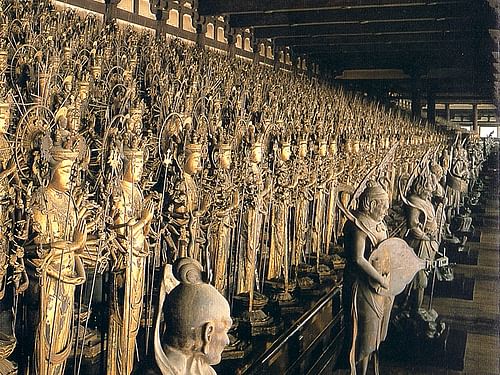
Sanjusangendo is a Buddhist temple which is part of the Rengeo-in monastery in Kyoto, Japan. Founded in 1164 CE, the temple is famous for its impressive dimensions and the 1,001 golden Buddha figures and 28 guardian statues which stand inside it. The temple is listed as a National Treasure of Japan.
THE TEMPLE HALL
The Sanjusangendo temple's official name is Rengeo-in which means 'Temple of the Lotus King Kannon-bosatsu' and is dedicated to Kannon (full name: Juichimen-Senjusengen-Kanzeon), the bodhisattva better known as Guanyin. The temple was founded in 1164 CE by the retired Emperor Go-Shirakawa (r. 1155-1158 CE) in Kyoto or Heiankyo as the then capital was known. Some sources credit the foundation to the court official Taira-no-Kiyomori (1118-1181 CE), a member of the powerful Taira clan. It was originally located in the centre of the Ho-juji Palace, the residence of Go-Shirakwa which was destroyed in 1183 CE with only the Sanjusangendo surviving.
THE GIANT GOLDEN FIGURE OF KANNON IS A NATIONAL TREASURE OF JAPAN & REPRESENTS THE FAMILIAR VISION OF THE ALL-SEEING & ALL-ENCOMPASSING BODHISATTVA.
The huge temple building has only one storey but is 120 metres (393 ft) long and 16.5 metres (54 ft) wide. The colloquial name of the building means 'a hall with 33 spaces between columns' and describes the facade of the building. 33 is also a number sacred to Kannon as the bodhisattva was thought to have had 33 manifestations and the most important pilgrimage route in his honour stops at 33 temples. There is a single entrance on all four sides, a veranda around the building, and the roof is tiled and gently sloping outwards and upwards at the corners.
The temple building is so large that it has long been used in archery contests beginning in the 16th century CE. The winner of such competitions had to fire the most arrows the entire length of the temple. To illustrate the difficulty of the task, in a contest in 1686 CE the winner, one Wasa Daihachiro, managed to fire only 8,133 of his 13,053 arrows the required distance. The tradition continues today in the annual Toh- shiya ('piercing arrow') competition held each February.
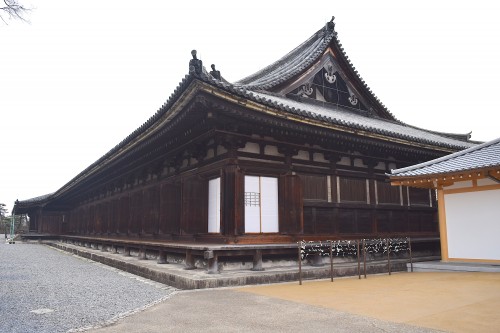
Main Hall, Sanjusangendo
The hall is in the native Japanese style ( Wayo ) as opposed to the more common temple architecture influenced by China.The exterior walls are painted red with the window frames in blue. Inside, the roof beams and rafters are left exposed, a typical feature of the Keshou - yaneura architectural style which dates back to the Nara Period (710-794 CE). The original temple was destroyed by a fire in 1249 CE but rebuilt exactly at the behest of the retired Emperor Go-Saga (r. 1242-1246 CE).Completed in 1266 CE, it has been renovated four times since then.
The Sanjusangendo temple is surrounded by an earth wall with a roof and accessed via two gateways. Both the wall and the South Gate date to 1590 CE when the regent Toyotomi Hideyoshi (1537-1598 CE) improved the site; both structures are in the Momoyama style and are listed as Important Cultural Properties of Japan.
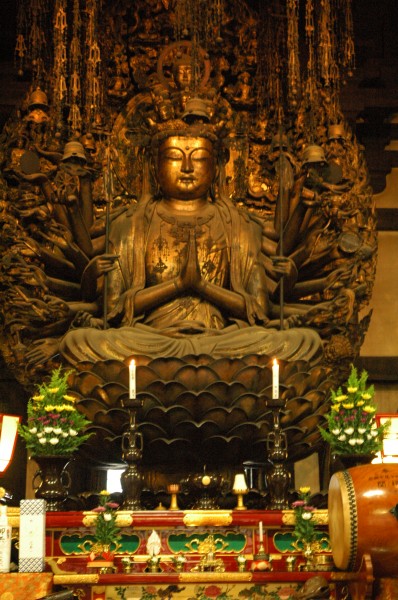
Kannon, Sanjusangendo
INTERIOR SCULPTURES
Inside the Sanjusangendo are many fine figure sculptures with the most important being the statue of the Thousand-armed Kannon. The giant seated golden figure of Kannon is a National Treasure of Japan and represents the familiar vision of the all-seeing, all-encompassing bodhisattva with eleven faces (one normal head and then one each for the eight directions plus one for heaven and one for earth) and 1,000 arms (a number representing infinity in Sanskrit ). This figure has the eleven faces represented as a crown of heads and 20 pairs of arms. On his halo, there are 31 miniature representations of the Buddha.Each hand holds an object of sacred significance such as a sutra scroll to represent learning, a willow tree for healing, a sword for banishing devils, and an axe to fight against misfortune. Kannon sits on an octagonal lotus flower with seven levels of petals. The figure is 3.3 metres (11 ft) in height. Ink inscriptions inside the body of the figure and on the lotus seat indicate it is the work of the great Kamakura Period (1185-1333 CE) sculptor Tankei, who was the leader of the Kei-ha school of Buddhist sculpture and who would have been 82 at its time of creation in 1254 CE.
Either side of the seated Kannon figure filling half the temple are 1,000 smaller statues of Kannon, each being around 1.7 metres (5.5 ft) in height. Made by a team of sculptors over a period of 15 years, they are near-identical with only very minor differences in facial expression and folds of the robe. Set in ten parallel tiers, they all face the same direction, east, and each has 20 arms and a halo with rays. All of the gilded figures are designated as Important Cultural Properties of Japan. 124 of them date to the original founding of the temple in the 12th century CE, while the other 876 were made a century later in imitation of the lost originals. Around 500 of the figures are signed by the sculptor on the base and include works by such famous names as Ryuen, Inga, Tankei (who made nine), and Koen, Tankei's great pupil and successor.

Shagara, Sanjusangendo
The main Kannon statue and the 1,000 smaller figures are all protected by 28 attendants and guardians, all placed on a raised platform and set in a single row in front. Standing around 1.6 metres (64 inches) tall, many derive from Indian Buddhism and mythology. A lively group of action figures, they each represent such concepts as beauty, wisdom, prosperity, charity, justice and strength. At either end of the hall, with each standing on a raised platform in the shape of a cloud, are two more figures, this time of Raijin, the god of thunder, and Fujin, the wind god. The statues are around one metre tall (40 inches) with the wind god represented holding a bulging sack full of wind while the thunder god is surrounded by a circle of eight small drums. Both figures date to the Kamakura Period.
All of the statues in the Sanjusangendo are made from cypress wood and by the same technique known as yosegi - zukuri, that is, with individual parts sculpted separately, joined and then coated with lacquer. Finally, the figures were either painted or gilded with gold leaf and the eyes set with quartz.
This article was made possible with generous support from the Great Britain Sasakawa Foundation.
Minamoto Clan › Ancient History
Definition and Origins
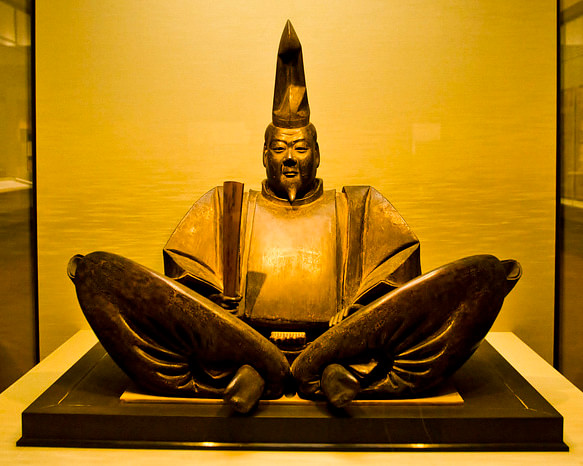
The Minamoto clan was an extended family group which dominated Japanese government and the imperial court in the 12th and 13th centuries CE. The clan famously defeated their arch rivals the Taira in the Genpei War of 1180-1185 CE and included such famous figures as Minamoto no Yoritomo, Japan ’s first shogun ruler.
JAPAN'S CLAN SYSTEM
From the 9th century CE in Japan, the process known as 'dynastic shedding' removed individuals from the dynastic lineage because the royal family became too large and too costly to maintain. With emperors having as many as 50 children, even direct descendants were removed from the royal line and given one of two family names: Minamoto (aka Minamoto-Shi or Genji ) or Taira (aka Hei-Shi or Heike ). The Minamoto name was first given as a surname to the children removed from the direct line of descent of Emperor Saga (r. 809-823 CE). The name Minamoto or Genji translates as 'spring' or 'fount'.Eventually, the family group expanded as successive emperors awarded the title name so that there were many different branches, for example, descendants of Emperor Seiwa (r. 858-876 CE) were known as 'Seiwa Genji'.
HACHIMAN, THE SHINTO GOD OF WAR & CULTURE, WAS THE PATRON OF THE MINAMOTO CLAN.
HACHIMAN AS PATRON
In the 11th century CE, Hachiman, the Shinto god of war, divination, and culture, was selected as the symbolic head and patron of the Minamoto clan, who could then claim lineage back to Emperor Ojin, considered an avatar of the god. Yorinobu (968-1048 CE) was the first Minamoto to make this claim in 1046 CE. Yoriyoshi (988-1075 CE), Yorinobu's son, strengthened the family ties to Hachiman by citing the god as the reason for his victory in the Earlier Nine Years War in 1062 CE against the Abe clan of Mutsu, who were Emishi tax evaders. Yoriyoshi built a shrine at Yui-no-go in Sagami (moved to Kamakura in 1191 CE), and from that point on ever more shrines were built, all funded and protected by the Minamoto.
Yoriyoshi's son Yoshiie (1042-1103 CE) was an equally formidable warrior, and he came to be known as Hachimantaro or 'First Son of Hachiman'. The legendary hero was named after the god following a dream by his father where Hachiman gave the youth a sword. Hachimanto was a famed archer, credited with being able to fire an arrow through three men at once, and he was the main reason the Japanese defeated the Ezo people of northern Honshu.
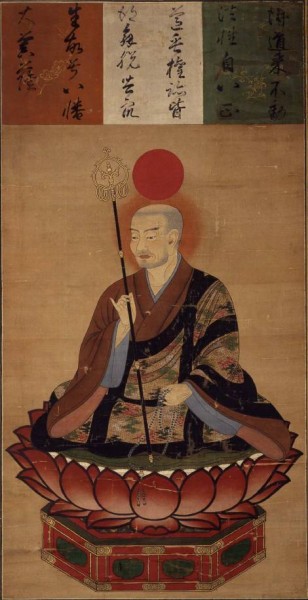
Hachiman
MINAMOTO V TAIRA
Both the Minamoto and Taira were militarily powerful and a bitter rivalry developed between them with each claiming a rightful inheritance to the throne. The aristocracy at court depended on one of the families according to their particular allegiance, and added to the mix was the influential Fujiwara clan which had provided regents throughout the Heian Period (794-1185 CE).
Almost inevitably armed conflict broke out between the rival clans, notably in the 1156 CE Hogen Disturbance when the two sides claimed the throne vacated by the death of retired Emperor Toba. The Taira prevailed, but 1160 CE saw another outbreak in hostilities with the Heiji Disturbance which involved, too, the Fujiwara clan. Once again the Taira were the winners.
THE GENPEI WAR
The Minamoto were not finished, and an even more significant battle for power broke out in 1180 CE with the Genpei War ( Genpei No Soran ). In the civil war, also known as the Taira-Minamoto War, the Minamoto now had the support of Mochito, the son of ex-emperor Go-Shirakawa, and they formed a rebel army led by Minamoto no Yoritomo.
Initially, the Taira did well with their commander Taira no Tomomori defeating Minamoto forces led by Minamoto no Yorimasa in 1180 CE and Minamoto no Yukie in 1181 CE at the Sunomata River. Things began to swing in favour of the Minamoto when a large rebel army led by Minamoto no Yoritomo scared off a smaller Taira force and he gained control of the Kanto region in eastern Japan by taking advantage of widespread disaffection with Taira rule, especially their policy of redistribution of land rights. Meanwhile, Kiso Yoshinaka, a cousin of Yoritomo, was causing havoc in the Kiso Mountains of Shinano, and in 1183 CE, he defeated a large Taira army at Kurikara in Etchu, clearing the way for an assault on the capital Heiankyo (Kyoto).
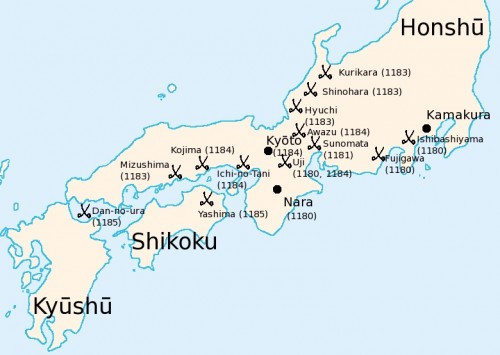
Battles of the Genpei War
Aside from battles and the burning of temples, the general population also had to endure natural disasters when a typhoon, earthquake, famine, and a plague all struck in the first five years of the 1180s CE. The war finally came to an end with the Battle of Dannoura in 1185 CE when the defeated leader of the Taira, Tomomori, and the claimant to the throne Antoku, who had fled Heiankyo, both committed suicide. In 1192 CE Yoritomo declared himself ruler of Japan from his military base at Kamakura. The Kamakura Shogunate lasted until 1333 CE, and Yoritomo would be the first of a long line of military rulers, several of them from the Minamoto clan, who would govern Japan for the next seven centuries.
IMPORTANT MINAMOTO MEMBERS
Minamoto no Tameyoshi (1096-1156 CE)
Minamoto no Tameyoshi was the head of the clan in the mid-12th century CE. In the 1156 CE Hogen Disturbance the retired emperor Sutoku was supported by Tameyoshi and some factions of the equally powerful Fujiwara clan led by Yorinaga.Meanwhile, the then emperor Go-Shirakawa was supported by Tameyoshi's eldest son, Yoshitomo, who joined with the Taira and other members of the Fujiwara, led by Tadamichi, Yorinaga's brother. The Go-Shirakawa side, with help from the military commander Taira no Kiyomori, quashed the rebellion, and Tameyoshi was executed along with a large number of Minamoto warriors.
Minamoto no Yoshitomo (1123-1160 CE)
Minamoto no Yoshitomo was the eldest son of Minamoto no Tameyoshi. He sided with Taira no Kiyomori and opposed his father during the Hogen Disturbance. Yoshitomo then became jealous of the rewards and prestige won by Taira no Kiyomori following his success in defeating Tameyoshi and so seized the throne in 1159 CE while his rival was away from court. This sparked the 1160 CE Heiji Disturbance when Taira no Kiyomori swiftly returned to restore order and Yoshitomo was killed.
Minamoto no Yoritomo (1147-1199 CE)
Minamoto no Yoritomo was the third son of Minamoto no Yoshitomo and his mother was a humble priest's daughter. Following his father's death, Yoritomo, then aged 13, and his siblings were exiled to the Izu region and looked after by Hojo Tokimasa.Yoritomo later married the daughter of his guardian, Hojo Masako.

Minamoto no Yoritomo
Yoritomo led a rebel army of some 200,000 men during the Genpei War according to the account the Tale of Heike ( Heikemonogatari ). The Taira sent an army of 70,000 to near Mt. Fuji to meet Yoritomo, but realising they were greatly outnumbered, the Taira force withdrew back to the capital, a capitulation which further swelled Yoritomo's numbers. Yoritomo did not pursue the enemy and for the time being concentrated on consolidating his almost total control of the eastern part of Japan. Yoritomo also strengthened his position by returning previously confiscated lands to the temples and nobility, eradicated banditry, was lenient in his treatment of prisoners, and, in 1183 CE, he received recognition from Go-Shirakawa of his authority in the east.Yoritomo now had the authority to appoint provincial military governors ( shugo ) and country-wide estate stewards ( jito ), amass wealth for himself and the court, reward loyal followers with confiscated estates, and to declare himself the only person in Japan with the right to raise an army. The emperor had the title and prestige but it was Yoritomo who was now poised to become the real ruler of Japan in practice.
Following victory in the Genpei War Yoritomo became jealous and suspicious of the popularity of his half-brother and deputy Minamoto no Yoshitsune. Yoshitsune had gained great glory in the naval victory at the Battle of Dannoura, and he was especially close to the retired emperor Go-Shirakawa. Yoritomo saw his brother as a serious rival for his own leadership of the Minamoto clan and, enraged when Yoshitsune accepted a governorship from the emperor without first consulting him, sent a force to eliminate his sibling.
YORITOMO WAS GIVEN THE REVIVED TITLE OF SHOGUN IN 1192 CE, MAKING HIM, IN EFFECT, THE RULER OF JAPAN.
Having defeated all rivals and dispatched his younger brother Minamoto no Noriyori and other key members of his own clan, Yoritomo stood alone at the head of the Minamoto. He was given the revived title of shogun in 1192 CE, making him, in effect, the ruler of Japan. He instigated several important reforms such as the creation of the Public Documents Office ( Kumonjo ) in Heiankyo. Yoritomo died in 1199 CE when he fell off his horse after opening a new bridge.
Minamoto no Yoshinaka (1154-1184 CE)
Minamoto no Yoshinaka (aka Kiso Yoshinaka) was a cousin of Yoritomo, who was the leader of an army based in the Kiso mountains of northern Japan. He defeated several small Taira forces and then won a major victory at Kurikara in 1183 CE during the Genpei War. Yoshinaka was then able to take the capital Heiankyo, forcing the Taira and young Emperor Antoku to flee south. The Minamoto commander pursued the enemy down the coast of Japan but his army, after long marches and several battles, was so weakened that Yoshinaka was defeated at Mizushima Bay by a reorganised Taira army, forcing him to return to Heiankyo.
Yoshinaka's short occupation of the capital was marred by looting and general misrule which resulted in a popular uprising led by armed monks from the Enryakuji and Onjoji temples and supported by the retired emperor Go-Shirakawa. Yoshinaka responded by burning down the emperor's palace and declaring himself shogun. Meanwhile, Yoritomo, concerned his cousin was becoming a threat to his own leadership of the clan, dispatched an assassin to remove him. When this plan failed, Yoritomo sent his two brothers Noriyori and Yoshitsune and their armies to Heiankyo to deal with Yoshinaka. The brothers won victories at Uji and Seta in 1184 CE, and Yoshinaka took his own life.

Minamoto no Yoshitsune
Minamoto no Yoshitsune (1159-1189 CE)
Minamoto no Yoshitsune was the younger half-brother of Minamoto no Yoritomo and son of Minamoto no Yoshitomo. His mother was Tokiwa Gozen. When his father was executed in 1160 CE, Yoshitsune and his five siblings escaped the usual practice where offspring of defeated warlords were killed and, instead, were exiled to the eastern provinces by Taira no Kiyomori. It was a generous move the Taira clan leader would later regret.
Yoshitsune commanded the force which defeated a Taira army at Ichinotano in the penultimate year of the Genpei War in which he acted as Yoritomo's second-in-command. In the final year, 1185 CE, he attacked the Taira base at Yashima and won the decisive naval Battle of Dannoura (Dannoura no Tatakai) in the Strait of Shimonoseki at the tip of Honshu island. Suffering the ambition of his brother, Yoshitsune was forced to seek shelter with Fujiwara no Hidehara but then, four years later in 1189 CE, was compelled to commit suicide when confronted by a force sent by Yoritomo to assassinate him. Yoshitsune became the archetypal wronged hero, and his tragic story became a staple theme of Japanese theatre and literature in later centuries, notably the No drama Funa Benkei.
Minamoto no Yorie (1182-1204 CE)
Minamoto no Yorie was the eldest son of Yoritomo who succeeded his father as shogun in 1202 CE. Yorie quickly faced competition for power from his mother Hojo Masako and her father Hojo Tokimasa - which may explain why it took three years to establish himself as shogun when his father died in 1199 CE - and was forced into exile in 1203 CE. A year later Yorie was assassinated, probably on Tokimasa's orders.
Minamoto no Sanetomo (1192-1219 CE)
Minamoto no Sanetomo was the second son of Yoritomo and brother of Yorie, who became shogun in 1203 CE with his mother Hojo Masako and her father Hojo Tokimasa acting as regents. Sanetomo was something of a poet and below is one example of his work which borrows from an earlier classic:
Rainy season dark:And in the uncertain light,a nightingale,Emerging from a distant peak,Sings as it approaches.(Keene, 701)
Sanetomo's 16-year reign came to a brutal end with his assassination in 1219 CE at the hands of his own nephew Kugyo, the son of Minamoto no Yorie. When the assassin was himself assassinated, it left the Yoritomo line extinct and all key government positions were subsequently held by Hojo family members.
This article was made possible with generous support from the Great Britain Sasakawa Foundation.
LICENSE:
Article based on information obtained from these sources:with permission from the Website Ancient History Encyclopedia
Content is available under License Creative Commons: Attribution-NonCommercial-ShareAlike 3.0 Unported. CC-BY-NC-SA License